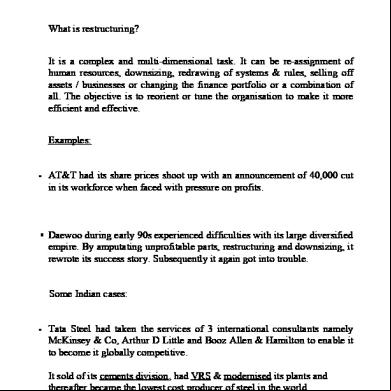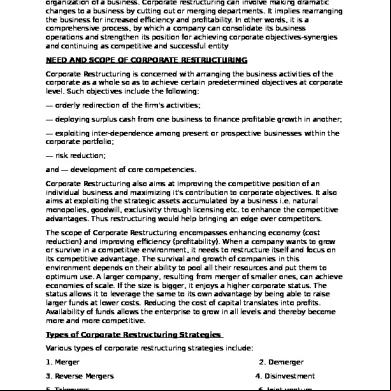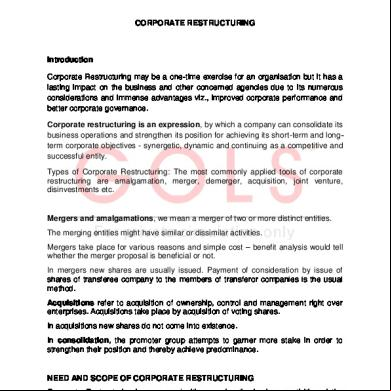Corporate Restructuring 67245w
This document was ed by and they confirmed that they have the permission to share it. If you are author or own the copyright of this book, please report to us by using this report form. Report 3b7i
Overview 3e4r5l
& View Corporate Restructuring as PDF for free.
More details w3441
- Words: 377
- Pages: 2
Corporate restructuring is defined as the process involved in changing the organization of a business. Corporate restructuring can involve making dramatic changes to a business by cutting out or merging departments. It implies rearranging the business for increased efficiency and profitability. In other words, it is a comprehensive process, by which a company can consolidate its business operations and strengthen its position for achieving corporate objectives-synergies and continuing as competitive and successful entity NEED AND SCOPE OF CORPORATE RESTRUCTURING Corporate Restructuring is concerned with arranging the business activities of the corporate as a whole so as to achieve certain predetermined objectives at corporate level. Such objectives include the following: — orderly redirection of the firm's activities; — deploying surplus cash from one business to finance profitable growth in another; — exploiting inter-dependence among present or prospective businesses within the corporate portfolio; — risk reduction; and — development of core competencies. Corporate Restructuring also aims at improving the competitive position of an individual business and maximizing it's contribution to corporate objectives. It also aims at exploiting the strategic assets accumulated by a business i.e. natural monopolies, goodwill, exclusivity through licensing etc. to enhance the competitive advantages. Thus restructuring would help bringing an edge over competitors. The scope of Corporate Restructuring encomes enhancing economy (cost reduction) and improving efficiency (profitability). When a company wants to grow or survive in a competitive environment, it needs to restructure itself and focus on its competitive advantage. The survival and growth of companies in this environment depends on their ability to pool all their resources and put them to optimum use. A larger company, resulting from merger of smaller ones, can achieve economies of scale. If the size is bigger, it enjoys a higher corporate status. The status allows it to leverage the same to its own advantage by being able to raise larger funds at lower costs. Reducing the cost of capital translates into profits. Availability of funds allows the enterprise to grow in all levels and thereby become more and more competitive. Types of Corporate Restructuring Strategies Various types of corporate restructuring strategies include: 1. Merger 3. Reverse Mergers 5. Takeovers
2. Demerger 4. Disinvestment 6. t venture
7. Strategic alliance
8. Slump Sale
9. Franchising etc.
10. Strategic alliance
https://www.icsi.edu/docs/webmodules/Publications/Full%20Book%20of%20PP-CRVI2014.pdf
2. Demerger 4. Disinvestment 6. t venture
7. Strategic alliance
8. Slump Sale
9. Franchising etc.
10. Strategic alliance
https://www.icsi.edu/docs/webmodules/Publications/Full%20Book%20of%20PP-CRVI2014.pdf











